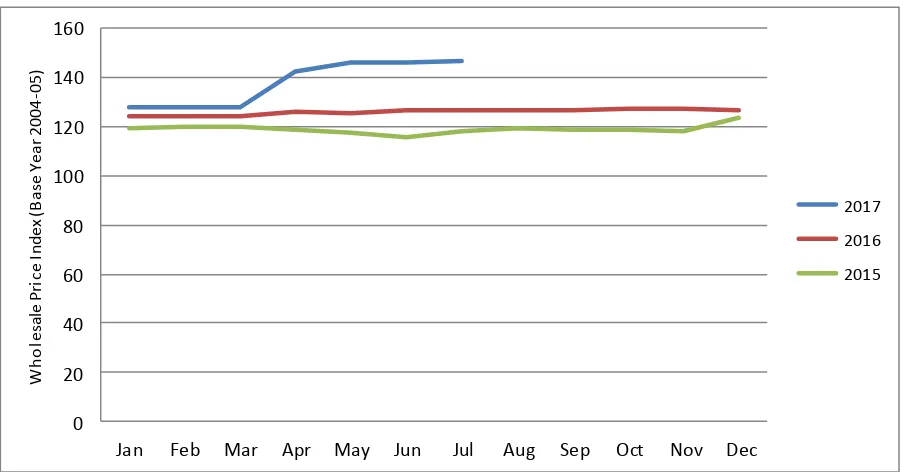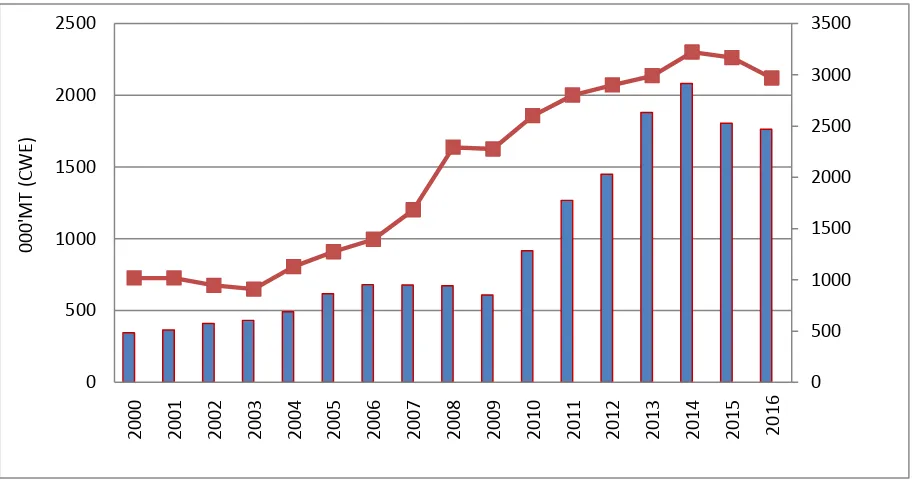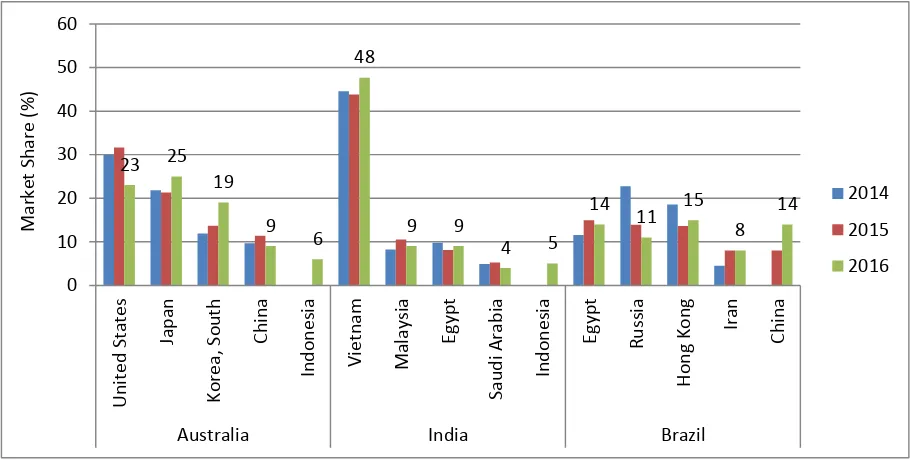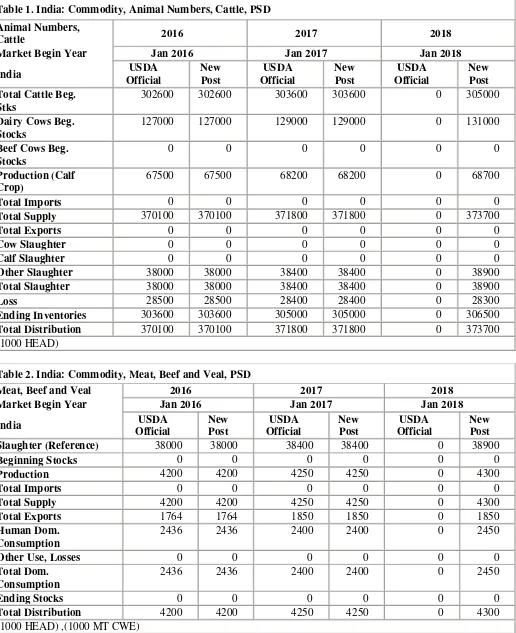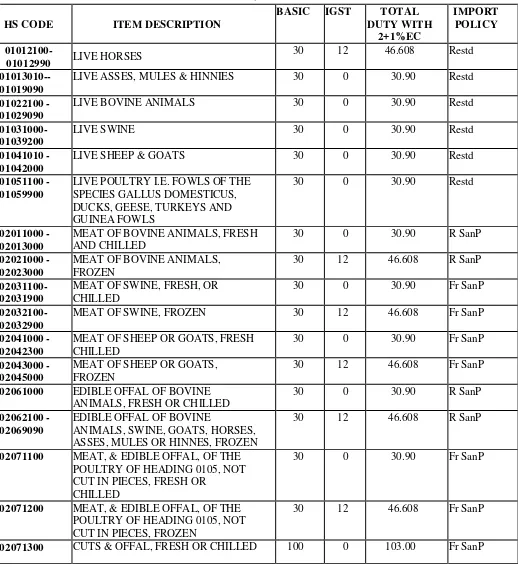THIS REPORT CONTAINS ASSESSMENTS OF COMMODITY AND TRADE ISSUES MADE BY USDA STAFF AND NOT NECESSARILY STATEMENTS OF OFFICIAL U.S. GOVERNMENT POLICY
Date: GAIN Report Number:
Approved By:
Prepared By:
Report Highlights:
CY 2018 water buffalo meat (carabeef) and beef production is projected to increase marginally by one percent to 4.3 million metric tons (MMT) carcass weight equivalent (CWE) due to population growth and moderate export demand. CY 2018 carabeef exports are projected at 1.85 million metric tons CWE on moderate export demand from the Middle East, Africa, and Southeast Asia.
Vijay Intodia Mark Wallace
2017
Livestock and Products Annual
India
Executive Summary:
The CY 2018 cattle (Bos taurus or Bos indicus) and water buffalo (Bubalus bubalis) population are estimated at 305 million head. CY 2018 carabeef and beef production is projected to increase marginally by one percent to 4.3 million metric tons CWE due to population growth and moderate export demand. CY 2018 carabeef exports are projected to remain flat at 1.85 million metric tons CWE on moderate demand from the Middle East, Africa, and Southeast Asia. CY 2017 carabeef export estimate is also lowered to 1.85 million metric tons on slow export pace.
Commodities:
Production:
India’s CY 2018 cattle (Bos taurus or Bos indicus) and water buffalo (Bubalus bubalis) population is estimated at 305 million head. CY 2018 carabeef andbeef production is forecast to increase marginally by 1.2 percent to 4.3 million metric tons CWE on population growth and steady export demand. CY 2017 carabeef production level estimates are lowered to 4.25 MMT CWE on slow export pace. Industry sources indicate that local factors which reduced exports, particularly in early CY 2017, include India’s demonetization policy: export-oriented slaughter operations did not have sufficient funds in cash to make payments to the traders and small farmers for the purchase of animals. In addition, the
government cracked down on illegal slaughter houses and meat shops in Uttar Pradesh, the state which is the largest producer of buffalo meat. Though the crackdown had no direct impact on legal export-oriented slaughter houses, the overall disruption of the live animal supply chain coupled with the impact of demonetization did affect the export trade marginally. By contrast, the closure of illegal meat
establishments and resulting social unrest did significantly affect domestic supplies of animals available for slaughter. In turn, carabeef and beef prices spiked in domestic markets during the last few months, though the rise is expected to be short-lived once the supply chain restabilizes. (Figure 1).
Most Indian states restrict or prohibit slaughter of cattle (Bos taurus or Bos indicus) due to religious sensitivities, so India’s meat sector mainly depends on slaughter of unproductive water buffalo cows and bulls (Bubalus bubalis) from the dairy sector. Strong growth prospects in the dairy sector will support increases in water buffalo and cattle herd size over the next decade. In fact, India’s water
buffalo population increased at an annual growth rate of about 1.3 percent per year from 1997 to 2012 to reach 108.7 million head. These animals are raised only for dairying purpose mostly by small and marginal farmers. They prefer water buffaloes because their higher-fat milk sells for better prices and also because the spent water buffaloes can be sold for slaughter.
India’s states which are major exporters of carabeef include Andhra Pradesh, Maharashtra, Punjab, and Uttar Pradesh, the state with the largest water buffalo population. (Figure 2) As for the supply of animals for slaughter, the dairy farmers generally sell water buffaloes to traders. The slaughter houses Meat, Beef and Veal
then procure these animals from these traders and pay them on the basis of carcass weight. According to industry sources, current prevailing price for adult water buffalo is around INR 150-160 per kg and INR 130-140 per kg for water buffalo male calves. Another source of animals for slaughter is weekly
livestock markets. Such markets are either owned by private or local government bodies and are intended to facilitate sale of animals by dairy farmers.
In May 2017, Government of India’s Ministry of Environment, Forest and Climate Change notified Prevention of Cruelty to Animals Rules 2017 (Regulation of Livestock Markets). These rules are intended to ensure welfare of the animals and provision of adequate facilities for their husbandry. The regulation also imposed widespread bans on the sale at livestock markets of cows, buffaloes and other bovines destined for slaughter. (Under the Rules, sale would only be approved to a farmer – not a trader – who must also certify the animal would not be slaughtered within six months of purchase.) To date the regulation has had only limited impact on production and trade because it was suspended by India’s Supreme Court soon after implementation. The rules are currently under review; restrictions affecting at least the slaughter of water buffalo may be rescinded.
Figure 1: India: Rising Buffalo meat and Beef Prices in Recent Months
0
Jan Feb Mar Apr May Jun Jul Aug Sep Oct Nov Dec
W
Source: Ministry of Commerce and Industry, Government of India
28%
2007 2012 % Share*
* Percent share of India’s total water buffalo population per Livestock Census, 2012.
Source: DAHDF, Government of India.
GOI supports state governments for implementation of disease control programs as well as veterinary services and other farm management programs; these programs help mitigate animal losses and maintain disease-free status for slaughter animals. For trade, the disease of concern is foot-and-mouth disease (FMD), though there were no reports of any major incidences in CY 2017. India implements an FMD control program in 351 districts across 13 states and 6 union territories; it is on the list of countries having FMD programs endorsed by the World Organization for Animal Health (OIE). India has also declared three zones as ‘FMD free Zones where vaccination is practiced’; these zones meet World Organization for Animal Health (OIE) guidelines and application has been submitted to OIE for their recognition.
Consumption:
India’s CY 2017 and CY 2018 beef and carabeef consumption is projected at 2.4 and 2.45 million metric tons CWE on population growth. Carabeefis India’s second most consumed animal protein after chicken meat due to its affordability. Carabeef is mainly consumed by the Muslim population and certain sections of the Hindu population. Approximately 80 percent of India’s population is Hindu. Consumption is reportedly higher in the Indian states of Kerala, Assam, West Bengal, Goa, Uttar Pradesh and the northeastern states. Carabeef and beef are mostly sold fresh in wet markets since there is negligible domestic demand for chilled or frozen products.
Processing:
within the city. Local butchers then make required cuts to supply the meat to retail and institutional buyers.
By contrast, the export trade is supplied almost exclusively by large-scale slaughter houses with modern processing facilities. Such businesses are approved and regulated by the Food Safety and Standards Authority of India (FSSAI) within the Ministry of Health and the Agricultural and Processed Food Products Export Development Authority (APEDA) within the Ministry of Commerce and Industry. As per APEDA statistics, there are 77 approved complexes having abattoirs with meat processing facilities as well as 32 separate meat processing facilities. APEDA provides technical support to help the industry improve sanitation and hygienic practices for exported meat products. According to industry sources, India’s total buffalo meat processing capacity is around 3 million metric tons per year. The processing facilities are located mostly in the states of Uttar Pradesh, Andhra Pradesh, Maharashtra, and Punjab. The Ministry of Food Processing Industries also implements various schemes to help modernize or improve abattoirs, cold chain operations, and food surveillance. For further details, please refer to FAS GAIN Report IN4080.
Trade:
CY 2018 carabeef exports are projected flat at 1.85 million metric tons CWE on moderate export demand from Middle East, Africa, and Southeast Asia. CY 2017 carabeef exports are lowered marginally to 1.85 million metric tons on slow export pace. The exports in CY 2017 for the period January-May increased marginally by 1.67 percent to 678.9 thousand metric tons in comparison to the same period last year. The CY 2016 export figure is amended to 1.764 million metric tons on revised customs data. From year 2011 to 2016, India’s carabeef exports increased at a compound annual growth rate of 6.8 percent with peak exports of 2.1 million metric tons realized in CY 2014 (Figure 3).
India’s top five carabeef export destinations in CY 2016 were Vietnam, Malaysia, Egypt, Saudi Arabia and Indonesia (Figure 4). Vietnam accounted for 48 percent of total Indian exports at 840 thousand metric tons followed by Egypt (9.4 percent), Malaysia (9.3 percent), Indonesia (4.6 percent) and Saudi Arabia (4.4 percent). Industry sources indicate that slack economies in some of the Middle East and African countries have depressed Indian carabeef exports, although the recent opening of the Indonesian market has helped recover some of those losses. Indonesia has granted market access for Indian
carabeef mainly due to rising demand for affordable carabeef meat in its different consumer segments. Note: an annual quota for Indian exports to Indonesia limits its potential growth as an Indian export market.
India exports only boneless carabeef, which is mostly thawed and resold in wet markets. Some carabeef is also used in processed products such as canned meat, sausage, salami, burgers, and other processed meat products. Indian carabeef is preferred due to its affordability, leanness, and halal characteristics. The meat is cheaper than beef supplied from some of the other major exporting countries such as United States, Australia, and Brazil, and this lower price point gains carabeef entry to markets which are
mostly closed to these premium beef suppliers. (Figure 5)
0
Source: Global Trade Atlas
Figure 4: India’s Top Five Carabeef Export Markets in Recent Years
928
Vietnam Thailand Malaysia Egypt Saudi Arabia Indonesia
Figure 5: Top Five Export Markets of Australia, Brazil and India, 2014 – 2016
Source: Global Trade Atlas
Policy:
Carabeef Meat Production Programs and Policy
Department of Animal Husbandry, Dairying and Fisheries (DAHDF) under the Ministry of Agriculture and Farmer’s Welfare supports state governments to implement control programs for various animal diseases, such as foot-and-mouth disease (FMD) and Brucellosis. In addition, DAHDF provides
financial and technical assistance to advance development of livestock genetics, and feed and fodder, as well as to expand dairy processing and marketing infrastructure. DAHDF also maintains a web-based animal disease reporting system to monitor livestock diseases and to recommend preventative measures as appropriate. Currently, DAHDF is implementing National Dairy Plan (NDP) through the National Dairy Development Board. This plan includes a program for breed improvement, artificial insemination, and fodder development; it also includes expanding milk procurement systems at the village level. The phase I of the NDP runs from IFY 2011-12 to 2018-19 and will have a total outlay of around $350 million. For further details on programs and policy please refer to FAS GAIN Reports IN6115 and IN5106.
The Government of India’s Food Safety and Standards Authority of India (FSSAI) regulates the domestic carabeef and beef slaughter and processing sector through the Food Safety and Standards Regulations (FSSR 2011). FSSR 2011 enforces sanitary standards and controls at all stages of meat production; it also requires registration and licenses for meat processors and other food operators in the value chain.
Imports: India prohibits the export and import of beef due to religious sensitivities. GOI’s DAHDF regulates all meat product imports through the Livestock Importation Act, 1898. In order to import meat products, the required documentation includes a sanitary import permit issued by DAHDF and a veterinary certificate certified by an exporting country’s competent authority. Indian import
certification requirements and documentation for livestock and livestock products are available at: http://dahd.nic.in/dahd/trade.aspx. Tariffs for selected livestock products are shown in Table 3. Information on import procedures are provided below:
Procedure for Import of Livestock notified under clause (b) of Section 2 of Livestock Importation Act, 1898
Procedure for import of live-stock products notified under Section 2(d) and section 3A of the Live-stock Importation Act
Sanitary Requirement(veterinary health certificate)for import of various livestock products. Guidelines for import/ export of bovine germplasm
Proforma for submitting proposals for introduction of live Aquatic Organisms Import Health certificate for import of Dogs for Commercial purpose into India Import Health certificate for import of Pet Dogs into India
Animal health certificates for import of live bovine in vivo bovine embryo and bovine frozen semen into India
Veterinary certificate for import of skin/hides into India Veterinary certificate for import of milk and milk products Veterinary Certificate for Import of Canine Semen into India Veterinary Certificate for Import of Equine Semen into India
Veterinary Certificate for Import of Ovine / Caprine Semen into India Animal Health Certificate for Import of Porcine Semen into India Veterinary Certificate for pork and pork products into India
Exports: GOI’s Agricultural and Processed Food Products Export Development Authority (APEDA) regulates all abattoirs and meat processing plants exporting carabeef and other meat products. Export shipments are subject to compulsory microbiological and other testing requirements for the issuance of animal health certificate by the certified GOI agency. The GOI has given the following agencies authority to issue health certificates:
1. All State Directorates of Animal Husbandry 2. Export Inspection Agencies (EIAs)
3. Directorate of Marketing and Inspection (DMI)
4. Deonar abattoir, Mumbai (for chilled sheep and goat meat only) 5. Ghazipur abattoir, Delhi (for carabeef, sheep, and goat meat) 6. Perumbur abattoir, Chennai (for carabeef, sheep, and goat meat)
Table 1. India: Commodity, Animal Numbers, Cattle, PSD Total Cattle Beg.
Stks
302600 302600 303600 303600 0 305000
Dairy Cows Beg. Stocks
Ending Inventories 303600 303600 305000 305000 0 306500
Total Distribution 370100 370100 371800 371800 0 373700
(1000 HEAD)
Table 2. India: Commodity, Meat, Beef and Veal, PSD
Table 3. India: Tariffs for Selected Livestock Products, 2017
HS CODE ITEM DESCRIPTION
BASIC IGST TOTAL
01012990 LIVE HORSES
30 12 46.608 Restd
LIVE POULTRY I.E. FOWLS OF THE SPECIES GALLUS DOMESTICUS, DUCKS, GEESE, TURKEYS AND GUINEA FOWLS
30 0 30.90 Restd
02011000 -02013000
MEAT OF BOVINE ANIMALS, FRESH AND CHILLED
30 0 30.90 R SanP
02021000 -02023000
MEAT OF BOVINE ANIMALS, FROZEN
30 12 46.608 R SanP
02031100-02031900
MEAT OF SWINE, FRESH, OR CHILLED
MEAT OF SHEEP OR GOATS, FRESH CHILLED
30 0 30.90 Fr SanP
02043000 -02045000
MEAT OF SHEEP OR GOATS, FROZEN
30 12 46.608 Fr SanP
02061000 EDIBLE OFFAL OF BOVINE
ANIMALS, FRESH OR CHILLED
30 0 30.90 R SanP
02062100 -02069090
EDIBLE OFFAL OF BOVINE
ANIMALS, SWINE, GOATS, HORSES, ASSES, MULES OR HINNES, FROZEN
30 12 46.608 R SanP
02071100
MEAT, & EDIBLE OFFAL, OF THE POULTRY OF HEADING 0105, NOT CUT IN PIECES, FRESH OR
CHILLED
30 0 30.90 Fr SanP
02071200 MEAT, & EDIBLE OFFAL, OF THE
POULTRY OF HEADING 0105, NOT CUT IN PIECES, FROZEN
30 12 46.608 Fr SanP
02071400 CUTS & OFFAL, FROZEN 100 12 127.36 Fr SanP Note: IGST: Integrated Goods & Services Tax , EC: Education Cess, Restd: Restricted, R SanP: Restricted Sanitary Permit, Fr SanP: Free Sanitary Permit
